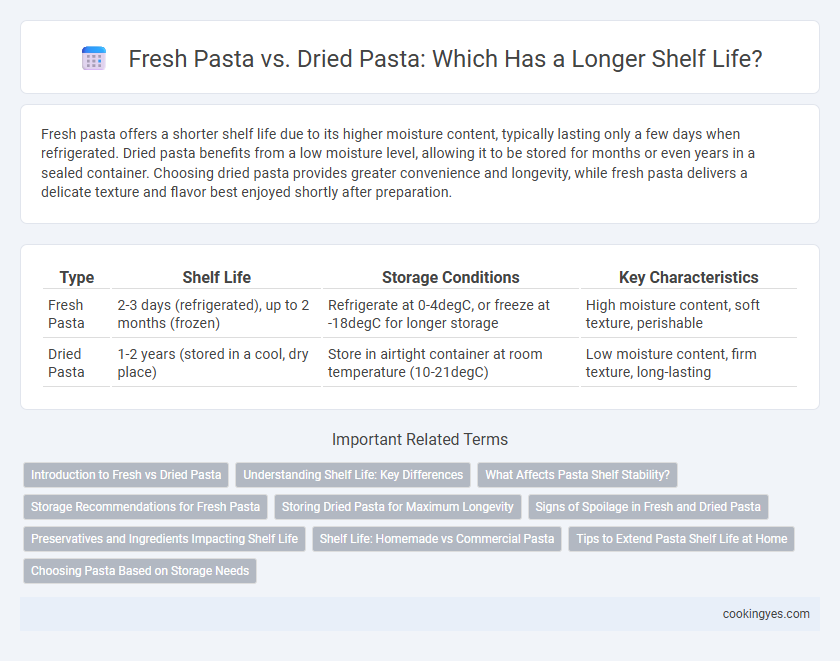Fresh pasta offers a shorter shelf life due to its higher moisture content, typically lasting only a few days when refrigerated. Dried pasta benefits from a low moisture level, allowing it to be stored for months or even years in a sealed container. Choosing dried pasta provides greater convenience and longevity, while fresh pasta delivers a delicate texture and flavor best enjoyed shortly after preparation.
Table of Comparison
| Type | Shelf Life | Storage Conditions | Key Characteristics |
|---|---|---|---|
| Fresh Pasta | 2-3 days (refrigerated), up to 2 months (frozen) | Refrigerate at 0-4degC, or freeze at -18degC for longer storage | High moisture content, soft texture, perishable |
| Dried Pasta | 1-2 years (stored in a cool, dry place) | Store in airtight container at room temperature (10-21degC) | Low moisture content, firm texture, long-lasting |
Introduction to Fresh vs Dried Pasta
Fresh pasta contains higher moisture content, typically around 30%, which significantly shortens its shelf life to just a few days under refrigeration. Dried pasta is dehydrated to less than 12% moisture, allowing storage at room temperature for up to two years without spoiling. The preservation methods directly impact freshness, texture, and ideal culinary uses in Italian cuisine.
Understanding Shelf Life: Key Differences
Fresh pasta typically has a shelf life of 2 to 3 days when refrigerated, due to its high moisture content, making it prone to bacterial growth. Dried pasta, on the other hand, can be stored for up to 1 to 2 years in a cool, dry place because its low moisture levels inhibit microbial activity. Proper storage conditions significantly impact shelf life, with airtight containers extending the longevity of both fresh and dried varieties.
What Affects Pasta Shelf Stability?
Pasta shelf stability is primarily influenced by moisture content, packaging methods, and storage conditions; fresh pasta contains higher moisture, making it prone to microbial growth and shorter shelf life, usually lasting only a few days under refrigeration. Dried pasta undergoes dehydration processes reducing water activity, which significantly extends its shelf life to several years when stored in a cool, dry environment. Factors such as exposure to humidity, temperature fluctuations, and airtight packaging critically impact the longevity and quality retention of both fresh and dried pasta varieties.
Storage Recommendations for Fresh Pasta
Fresh pasta has a significantly shorter shelf life compared to dried pasta, typically lasting only 2 to 3 days when stored in the refrigerator at temperatures between 34degF and 40degF (1degC to 4degC). To maintain freshness and prevent spoilage, fresh pasta should be kept in an airtight container or tightly wrapped in plastic wrap to minimize exposure to air and moisture. For longer storage, freezing fresh pasta at 0degF (-18degC) can extend its shelf life up to 2 months without compromising texture or flavor.
Storing Dried Pasta for Maximum Longevity
Storing dried pasta in a cool, dry place away from direct sunlight significantly extends its shelf life, often up to two years or more. Using airtight containers prevents moisture and pests from compromising quality, ensuring the pasta maintains its texture and flavor. Proper storage conditions help preserve nutritional value and prevent spoilage, making dried pasta a convenient pantry staple.
Signs of Spoilage in Fresh and Dried Pasta
Fresh pasta shows signs of spoilage through discoloration, off smells, and a slimy texture, typically lasting only 2 to 3 days in the refrigerator. Dried pasta has a much longer shelf life, often up to 1 to 2 years, but spoilage can be identified by mold growth, an unusual odor, or a brittle, crumbly texture. Proper storage in airtight containers and cool, dry environments extends the usability of both pasta types while preventing spoilage.
Preservatives and Ingredients Impacting Shelf Life
Fresh pasta typically contains higher moisture content and fewer preservatives, resulting in a shorter shelf life of 2 to 3 days when refrigerated. Dried pasta undergoes a dehydration process and often includes additives like hydrogenated oils or antimicrobials that extend shelf life to 1-2 years when stored in a cool, dry place. The presence of preservatives in dried pasta inhibits microbial growth, while the fresh pasta's minimal ingredient list offers limited protection against spoilage.
Shelf Life: Homemade vs Commercial Pasta
Homemade fresh pasta typically has a shelf life of 1 to 2 days when stored in the refrigerator, due to its higher moisture content and absence of preservatives. Commercial fresh pasta often contains preservatives and vacuum-sealing, extending its refrigerated shelf life up to 1 to 3 weeks. Dried pasta offers a significantly longer shelf life, averaging 1 to 2 years when stored in a cool, dry place, making it ideal for long-term storage compared to both homemade and commercial fresh pasta.
Tips to Extend Pasta Shelf Life at Home
Fresh pasta typically lasts 2 to 3 days in the refrigerator, while dried pasta can be stored for up to 1 to 2 years in a cool, dry place. To extend fresh pasta's shelf life, keep it tightly sealed in an airtight container or plastic wrap and store it at a consistent refrigerator temperature below 40degF (4degC). For dried pasta, avoid exposure to moisture and heat by using airtight containers and storing in a pantry away from sunlight.
Choosing Pasta Based on Storage Needs
Fresh pasta typically has a shelf life of 1 to 2 days when refrigerated, requiring immediate consumption or freezing for extended storage, while dried pasta can last up to 1 to 2 years when stored in a cool, dry place. Choosing pasta based on storage needs depends on usage frequency and kitchen space; dried pasta is ideal for long-term pantry storage and emergency reserves. Fresh pasta offers superior texture and flavor for short-term meals but demands prompt use or freezing to prevent spoilage.
Fresh Pasta vs Dried Pasta for Shelf Life Infographic

 cookingyes.com
cookingyes.com